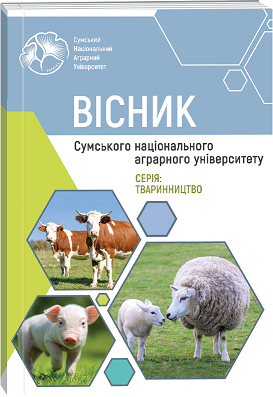ЯКІСНІ ПОКАЗНИКИ ПЕРЕПЕЛИНИХ ЯЄЦЬ ЗА ЗГОДОВУВАННЯ СУХОЇ ПІСЛЯСПИРТОВОЇ БАРДИ
Анотація
Актуальним питанням сьогодення є утилізація відходів переробної промисловості шляхом згодовування їх тваринам з метою отримання різних продуктів тваринного походження, у тому числі і перепелиних яєць. З цією метою було проведено науково-господарський досліду з визначення впливу згодовування перепелам яєчного напряму продуктивності сухої післяспиртової барди у складі комбікормів у кількості 5–20 % на якісні показники яєць. На початку досліду японських перепелів віком 42 доби за принципом аналогів поділили на 5 груп, з яких 1-а була контрольною, а 2–5-а – дослідними. До складу кожної групи включили 24 самки та 6 самців. У комбікормах тварин 1-ї контрольної групи суха післяспиртова барда була відсутня. Тварини 2-ї дослідної групи споживали комбікорми з вмістом 5 % сухої післяспиртової барди, 3-ї дослідної групи – 10 %, 4-ї дослідної групи – 15 % та 5-ї дослідної групи – 20 % вказаного кормового засобу. Доведено, що найвищої яєчної продуктивності перепели досягають споживаючи у складі комбікорму 10 % сухої післяспиртової барди. Позитивно впливає на несучість перепелів також уведення у їх комбікорм 5 та 15 % вказаного кормового засобу. Схожа тенденція мала місце і за масою яєць. Так, найвищим цей показник був у тварин, що споживали комбікорм з вмістом 10 % сухої післяспиртової барди. За вмісту в раціоні перепелів 5 та 15 % вказаного кормового засобу маса знесених ними яєць теж переважали контроль, проте з нижчими значеннями. Підвищення частки сухої післяспиртової барди в комбікормі до 20 % негативно вплинуло як на несучість, та і на масу яєць перепелів. Разом з тим, аналіз хімічного та морфологічного складу яєць довів, що якісні показники яєць перепелів мало залежать від частки сухої післяспиртової барди при вмісті її у комбікормі у кількості 5–20 % за масою комбікорму. Зміни хімічного та морфологічного складу яєць перепелів за згодовування сухої післяспиртової барди не мали статистичної значущості. Таким чином, оптимальним вмістом сухої післяспиртової барди в комбікормах перепелів яєчного напряму продуктивності можна вважати 10 %.

 ISSN
ISSN  ISSN
ISSN 



